Are microbes, methane behind Mars's carbon cycle? Study investigates
Scientists present three possible explanations for what seems to be a very unusual carbon cycle on the red planet. But all three have issues and are unlike anything we have on Earth.
By AARON REICH, Jerusalem Post, JANUARY 18, 2022

Mars, the fourth planet from the Sun (illustrative). (photo credit: PIXABAY)
The element carbon is said to be the most essential building block
for life, necessary for both biological life and for the maintenance of
our ecosystem. They are tracers of all biological activity. So, if
carbon exists on Mars, could that indicate the presence of life?
In 2012, NASA’s Curiosity Rover
touched down on the red planet and sent results from samples back to
researchers, including finding carbon isotopes in sediments. There are
two stable types of such isotopes, carbon-12 and carbon-13, and the
samples were extremely low in carbon-13 in some places while higher in
others.
The carbon
on Mars has to come from somewhere. Now, scientists writing in a study
published in the peer-reviewed academic journal Proceedings of the National Academy of Sciences have three ideas for where.
Cosmic dust or UV radiation?
The first possible explanation comes from cosmic dust. Essentially,
the solar system would have needed to pass through a galactic molecular
cloud. This itself makes sense – after all, this does happen every
couple of hundred million years.

Mars screenshot from Celestia 3D astronomy program. (credit: VIA WIKIMEDIA COMMONS)
When
this (hypothetically) happened, temperatures on Mars could have
decreased, which would cause liquid water on the surface – if it existed
– to freeze into glaciers, which would have a layer of dust on top of
them.
The second theory suggests that ultraviolet radiation converted carbon dioxide into organic compounds.
The
third possible explanation is biological in nature. Essentially,
microscopic life forms feasting on methane could have produced carbon.
This is exactly what happened on Earth in the past.
According
to Christopher H. House, geosciences professor at Penn State University
and the study’s lead author, “The samples extremely depleted in
carbon-13 are a little like samples from Australia taken from sediment
that was 2.7 billion years old.” Those samples had a biological origin,
when methane was consumed by ancient microbial mats.
But all of these possible explanations have issues. Specifically,
they make no sense in relation to what we know about how it works on
Earth.
“All three of these scenarios are unconventional, unlike processes common on Earth,” the researchers noted.
The flaws in the theories
Why are they all problematic?
The
first theory, which suggests a galactic dust cloud, hinges on the
presence of glaciers. While Mars does indeed have some, the samples
gathered by Curiosity were from the Gale Crater, where there is very
limited evidence of any glaciers.
It
is therefore technically possible that this is what happened, but we
simply don’t know enough about it at this time to say for sure.
The
second theory has similar issues. Studies have predicted that
ultraviolet radiation could cause carbon to happen, but experimental
results showing it is currently lacking. More data would be needed to
give support to this possibility.
But what about the biological option? Could microbes eating methane have led to this?
Well, that relies on the presence of microbes and methane.
Methane
was present on Mars. That much has already been detected by Curiosity.
But the questions remain: Was there enough, and were there microbes to
consume it?
Methane
plumes would be needed to release methane onto the surface, and those
could have possibly existed where they would be consumed by microbes.
But
despite a biological process being a possible reason for the carbon,
the fact remains that this alone isn’t proof of biological life. Indeed,
there is no evidence of microbes ever having been on the Martian
surface.
If
evidence of microbes or glacial deposits in the area were conclusively
found, that would clear things up, but for now, there isn’t any.
“All three possibilities point to an unusual carbon cycle unlike anything on Earth today,” House said in a statement.
“But
we need more data to figure out which of these is the correct
explanation,” he said. “It would be nice if the rover would detect a
large methane plume and measure the carbon isotopes from that, but while
there are methane plumes, most are small, and no rover has sampled one
large enough for the isotopes to be measured.”
The
differences between the carbon cycle of Mars and how vastly different
it is compared to what has happened on Earth highlight just how much
more there is to learn about the other planets in our solar system.
THIS PAGE WAS POSTED BY SPUTNIK ONE OF THE SPUTNIKS ORBIT BLOG
PLEASE RECOMMEND THIS PAGE AND FOLLOW US AT:

No comments:
Post a Comment
Stick to the subject, NO religion, or Party politics